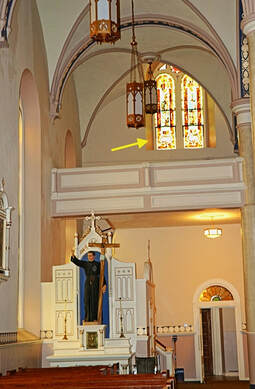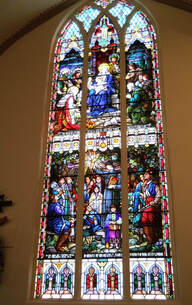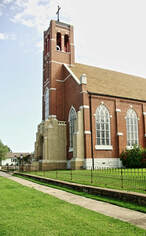Father Schoenmakers' Windows.
I wonder how many local parishioners have noticed the Father John Schoenmakers memorial window in St. Francis de Heironymo Catholic Church in St, Paul, Kansas. It is tucked into a secluded spot in the back of the church. On the other hand, Father John’s window in Oklahoma is hard to miss!
I wonder how many local parishioners have noticed the Father John Schoenmakers memorial window in St. Francis de Heironymo Catholic Church in St, Paul, Kansas. It is tucked into a secluded spot in the back of the church. On the other hand, Father John’s window in Oklahoma is hard to miss!
A Rather Obscure Corner For Such a Great Man.
It might seem odd that Father John Schoenmakers’ stained glass window is in a remote corner of the choir loft. He started our St. Francis de Heironymo Catholic Parish when he and the other Jesuit missionaries arrived in 1847. He founded our town of Osage Mission/St. Paul. He also started construction of our existing church building in 1871 and oversaw the project for years. Father John passed a few months before the May, 1884 dedication of his church, but the church, and our town, would not be here were it not for him and our Osage brothers and sisters. [1]
It might seem odd that Father John Schoenmakers’ stained glass window is in a remote corner of the choir loft. He started our St. Francis de Heironymo Catholic Parish when he and the other Jesuit missionaries arrived in 1847. He founded our town of Osage Mission/St. Paul. He also started construction of our existing church building in 1871 and oversaw the project for years. Father John passed a few months before the May, 1884 dedication of his church, but the church, and our town, would not be here were it not for him and our Osage brothers and sisters. [1]
 Fr. John's Window at St. Francis.
Fr. John's Window at St. Francis.
Well … Maybe Not So Odd.
St. Francis de Heironymo Catholic Church, in St. Paul, Kansas, is a beautiful, classic sandstone structure with a very distinctive steeple. The interior is of Romanesque design featuring high, arched ceilings and matching arched-top windows. When the church was built, there were fifteen 18’ tall windows — eight on the east side and seven on the west side. A door on the west side has a smaller round window above it, with similar design of the others. There are smaller windows in the ends of the church, in the steeple, and more inside. [2]
When the church was dedicated in 1884, the windows were plain, clear glass. After thirteen years of slow, finance-driven, construction the Jesuits and parishioners were happy to have the structure closed in. Finish work would come later. In the spring of 1900, the Kansas City Stained Glass Works installed the present traditional windows. Like many older churches, most of the windows were paid for with parishioner’s donations. If you walk through St. Francis you will see white oval panes near the base of the windows with names. Some names are of the family who donated the window. Some are memorials to past family members. Chances are, Father Schoenmakers 10’ tall window was paid for by the Passionists or a local family. But he did get a window to go along with a very large steeple bell that Father Ponziglione blessed, in his memory, on December 8, 1883.
St. Francis de Heironymo Catholic Church, in St. Paul, Kansas, is a beautiful, classic sandstone structure with a very distinctive steeple. The interior is of Romanesque design featuring high, arched ceilings and matching arched-top windows. When the church was built, there were fifteen 18’ tall windows — eight on the east side and seven on the west side. A door on the west side has a smaller round window above it, with similar design of the others. There are smaller windows in the ends of the church, in the steeple, and more inside. [2]
When the church was dedicated in 1884, the windows were plain, clear glass. After thirteen years of slow, finance-driven, construction the Jesuits and parishioners were happy to have the structure closed in. Finish work would come later. In the spring of 1900, the Kansas City Stained Glass Works installed the present traditional windows. Like many older churches, most of the windows were paid for with parishioner’s donations. If you walk through St. Francis you will see white oval panes near the base of the windows with names. Some names are of the family who donated the window. Some are memorials to past family members. Chances are, Father Schoenmakers 10’ tall window was paid for by the Passionists or a local family. But he did get a window to go along with a very large steeple bell that Father Ponziglione blessed, in his memory, on December 8, 1883.
 Schoenmakers Window
Schoenmakers Window
There is Another Window.
The Immaculate Conception Catholic Church in Pawhuska, Oklahoma, is also the “Cathedral of the Osage.” The building is of Cruciform shape and features several imported stained glass windows. The windows in the north and south transepts, that form the cross shape, have special meaning. The window in the north transept should have special meaning in St. Paul, Kansas. That 36’ tall window depicts Father Schoenmakers ministering to a group of Osage adults and children. The fact that the window included images of living Osages, at the time, required permission from the Vatican.
Why would a priest from a location 120 miles from Pawhuska get so much respect? This quote from a noted Osage historian and author sums it up:
The Immaculate Conception Catholic Church in Pawhuska, Oklahoma, is also the “Cathedral of the Osage.” The building is of Cruciform shape and features several imported stained glass windows. The windows in the north and south transepts, that form the cross shape, have special meaning. The window in the north transept should have special meaning in St. Paul, Kansas. That 36’ tall window depicts Father Schoenmakers ministering to a group of Osage adults and children. The fact that the window included images of living Osages, at the time, required permission from the Vatican.
Why would a priest from a location 120 miles from Pawhuska get so much respect? This quote from a noted Osage historian and author sums it up:
“The Jesuits and Sisters of Osage Mission, probably more than any other outside factor, were responsible for the survival of the Osage people. It is no small wonder that eighty percent of the Osages are still Catholic today. These dedicated souls accomplished more than they lived to realize. Their Influence on the souls and aspirations of the Osage people is still present today.”
Louis F. Burns, A History of the Osage People, 1989
 Immaculate Conception Catholic Church, Pawhuska.
Immaculate Conception Catholic Church, Pawhuska.
Chapter 6 of “Our Story” describes some of the epidemics, deaths and other problems the Osage and the missionaries faced together. This is probably why one of Father Schoenmakers nicknames was “The Apostle to the Osages.” [3][4]
Road Trip?
Folks planning a trip to the Pioneer Woman Mercantile, in Pawhuska, would do well to include a stop at the Immaculate Conception Catholic Church. It could even be combined with a visit to the Osage Museum, the Visitor Center and other local attractions. St. Paul travelers could learn a little more about themselves while there. See note [5] below for some links and there is much more available on the internet. However, a couple of things should be considered.
Road Trip?
Folks planning a trip to the Pioneer Woman Mercantile, in Pawhuska, would do well to include a stop at the Immaculate Conception Catholic Church. It could even be combined with a visit to the Osage Museum, the Visitor Center and other local attractions. St. Paul travelers could learn a little more about themselves while there. See note [5] below for some links and there is much more available on the internet. However, a couple of things should be considered.
- Visitors should check with the church to make sure it is open. The first link under note 5, is the parish website. Check their contact link.
- Immaculate Conception is an active Catholic Church. Visitors should be respectful and quiet. Do not approach the altar area!
- Back to Father Schoenmakers.
- Back to The Missionaries.
Some Reference Information:
1. Father John Schoenmakers died on July 28, 1883. Follow THIS LINK for a brief profile on Father Schoenmakers, including information about the Pawhuska windows and the Osage word for "priest". HERE is some information about the construction and completion of his church.
2. A large window on the west side of the church, at the north-west corner, is gone. When the Passionist Monastery was built in 1912, that opening accommodated doors between the monastery and the church. The lower door was in the sacristy and the upper door led into the church’s upstairs chapel area. When the monastery was razed in 1985 the opening was closed with sandstone masonry.
3. Father Schoenmakers probably had several “names.”
4. I first saw the term “Apostle to the Osages” in W.W. Graves' book “Rev. Father John Schoenmakers S. J., Apostle to the Osages,” Copyright 1928. More recently I found that term as the title of a magazine article by Matt Duhrr, that was republished in The Osage Magazine, Pawhuska, Oklahoma. That article appeared in Volume 10, Number Three of the Indian School Journal, January 1910. This document, including all of the issues for that year is available on Google Books. https://play.google.com/books/reader?id=JH9_bv0xYgcC&pg=GBS.RA2-PA2
5. Some Links to The Immaculate Conception Catholic Church and other Pawhuska/Osage County sites:
1. Father John Schoenmakers died on July 28, 1883. Follow THIS LINK for a brief profile on Father Schoenmakers, including information about the Pawhuska windows and the Osage word for "priest". HERE is some information about the construction and completion of his church.
2. A large window on the west side of the church, at the north-west corner, is gone. When the Passionist Monastery was built in 1912, that opening accommodated doors between the monastery and the church. The lower door was in the sacristy and the upper door led into the church’s upstairs chapel area. When the monastery was razed in 1985 the opening was closed with sandstone masonry.
3. Father Schoenmakers probably had several “names.”
- “The Apostle to the Osages” recognized the love and protection he showed toward the Osage People. [4]
- “The Father of Civilization in Southeast Kansas” refers to his early entry into unsettled southern Kansas. During his time here he and the missionaries under him, took a very active part in the promotion of civilization in Kansas and adjoining states. He also exercised his authority with the government, the Osages and settlers to achieve a favorable resolution when railroad company robber barons were grabbing large parcels of newly available land under the pretext of right-of-ways.
- I suspect those railroad executives also had a few choice names for the holy man. The same might be said of the Confederate officers he infuriated by encouraging most of the Osages to remain loyal to the Union. His unpopularity with the Confederates led to an exile from the mission in 1862-63.
- Follow these links for more information about WAR and the RAILROAD issues during the Osage departure from Kansas.
4. I first saw the term “Apostle to the Osages” in W.W. Graves' book “Rev. Father John Schoenmakers S. J., Apostle to the Osages,” Copyright 1928. More recently I found that term as the title of a magazine article by Matt Duhrr, that was republished in The Osage Magazine, Pawhuska, Oklahoma. That article appeared in Volume 10, Number Three of the Indian School Journal, January 1910. This document, including all of the issues for that year is available on Google Books. https://play.google.com/books/reader?id=JH9_bv0xYgcC&pg=GBS.RA2-PA2
5. Some Links to The Immaculate Conception Catholic Church and other Pawhuska/Osage County sites:
- The Immaculate Conception Parish Website.
- The Church Facebook Page.
- A PDF file from Stained Glass.org about The Church.
- Here is a LINK to an Osage County and area visitors site.
- A video about Immaculate Conception Catholic Church ...
6. All photos in this article were taken by Ron Brogan of A Catholic Mission.
